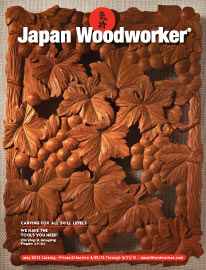|
|
 |
 |
 |
| How to Sharpen Japanese Chisels |
posted on 11:56am by David |
|
 |
Instructions for sharpening Japanese Chisels.
Each chisel is inspected prior to shipment to assure that it meets our own rigid standards. While each chisel is ground sharp by the maker, we can not guarantee each edge will be ground perfectly square and free of minor nicks. However, edges of this sort are few and far between.

When a new chisel with a hooped handle is received, quite often the hoop is loose. This is common to all Japanese chisels. The function of the hoop is solely to keep the handle from splitting. Therefore, the hoop should be properly seated prior to use. To do this, first remove the hoop from the handle and place the top portion of the handle on an anvil, With a metal hammer firmly tap all around the top 5/8" of the handle. The idea is to compress the wood so that the hoop can be driven approximately 1/32" to 1/16" below the top of the handle. Then place the handle in a container of a oil base sealer (I prefer to use tung oil based products) and allow to stand overnight. This will cause the handle to swell lock the hoop in place.
Many woodworkers are initially concerned that the flat area directly behind the cutting edge will be eliminated with repeated sharpening thus rendering the chisel useless. However, this will not occur if the following simple sharpening steps are taken.
It is best practice to hone a new chisel prior to use. First, hone the back of the blade on a flat coarse stone (#1000-#1200 grit water stone preferred) until the area directly behind the cutting edge is completely flat across the width of the chisel. To do this, rub the back of the chisel side ways along the length of the stone. The proper technique is to keep the chisel flat on the stone with finger pressure applied directly on the bevel. Keep rubbing until the area directly behind the cutting edge is flat. This will be obvious by inspection. Second, transfer the chisel to a flat #6000 to #12000 grit finish stone and hone as above until a mirror surface is obtained.
Future sharpening will require that the chisel back be honed only on the Finish stone until after repeated sharpening the cutting edge reaches the hollow grind. When this happens, it is easily corrected by following the above procedure until about 1/32" of flat area is reestablished.
After the back has been honed and polished, the bevel of the chisel is sharpened. This is done by rubbing the bevel on a flat coarse stone until the "burr" is formed. At this point, transfer the chisel to the finish stone and alternately hone the bevel and back of the chisel until a razor edge is obtained.
Should the you have any difficulty with the above or any other aspect of sharpening or caring for Japanese chisels, please feel free to contact us.
Copyright ©2005 Japan Woodworker
|
|
|
 |
|
 |
|
|
 Click Here to View Catalog
Click Here to View Catalog